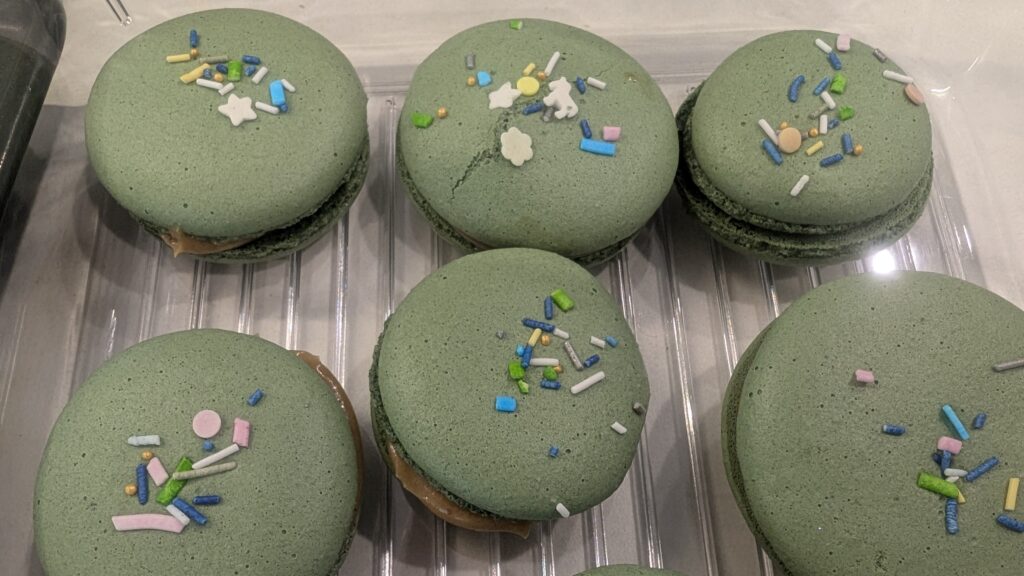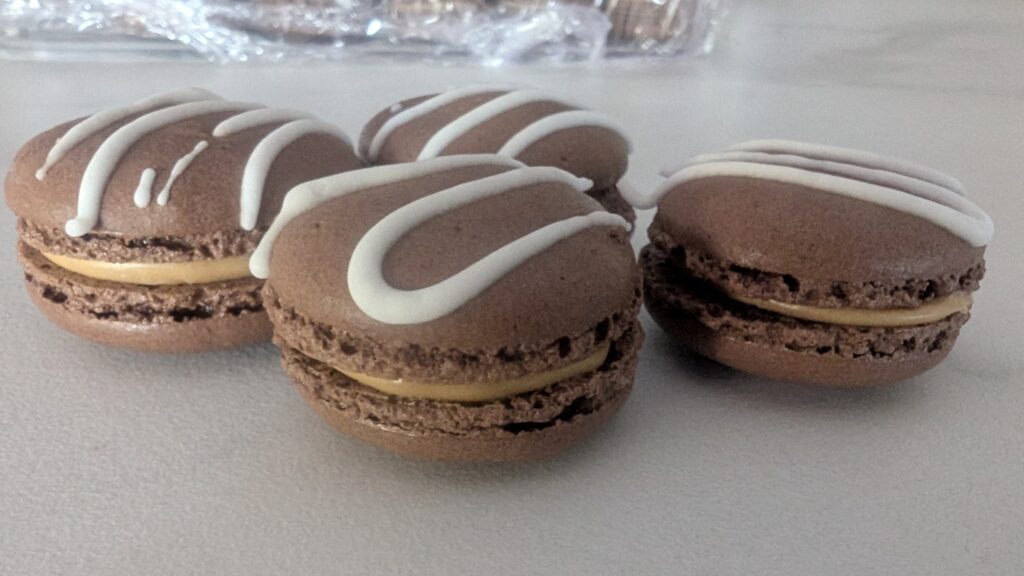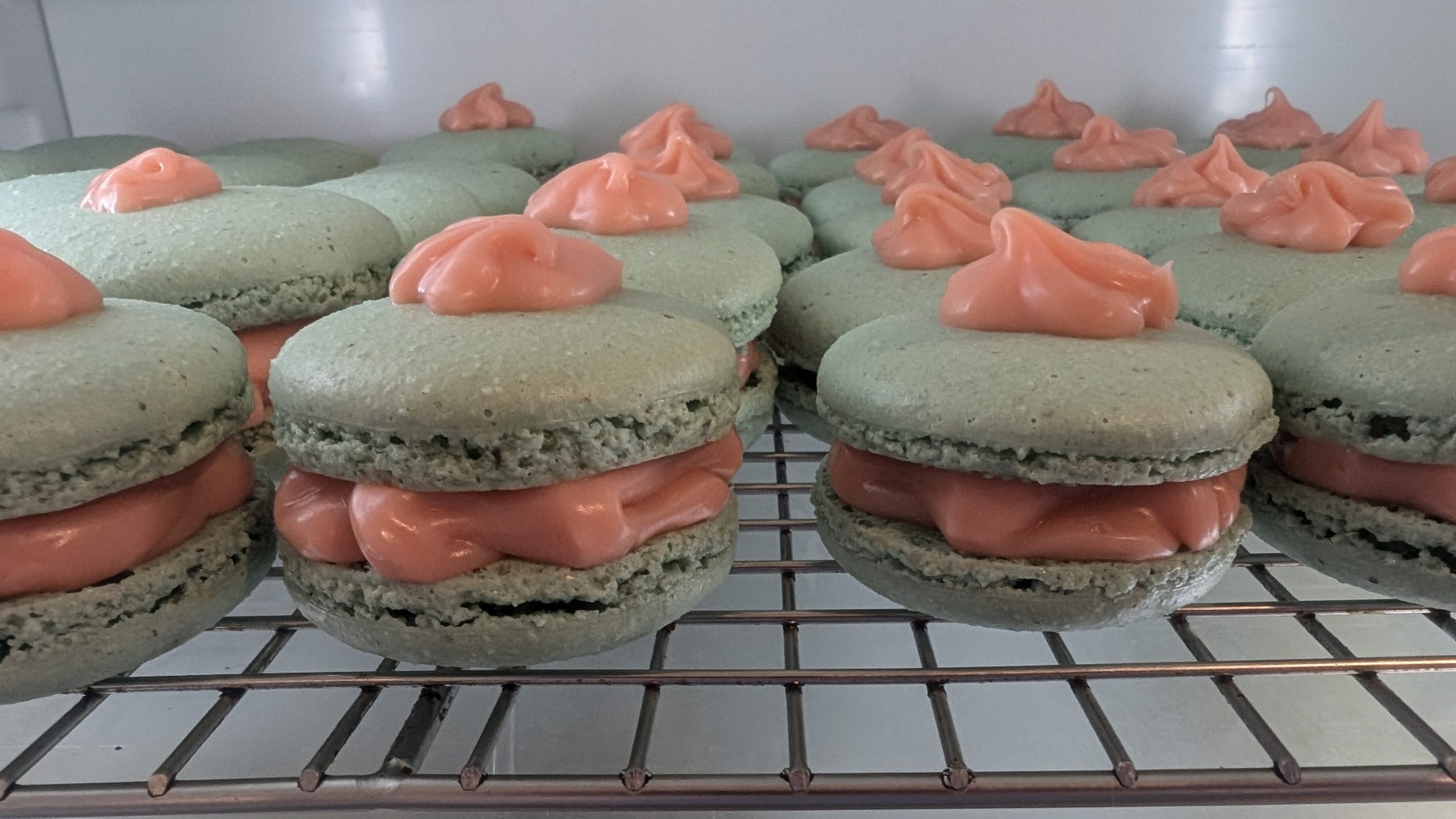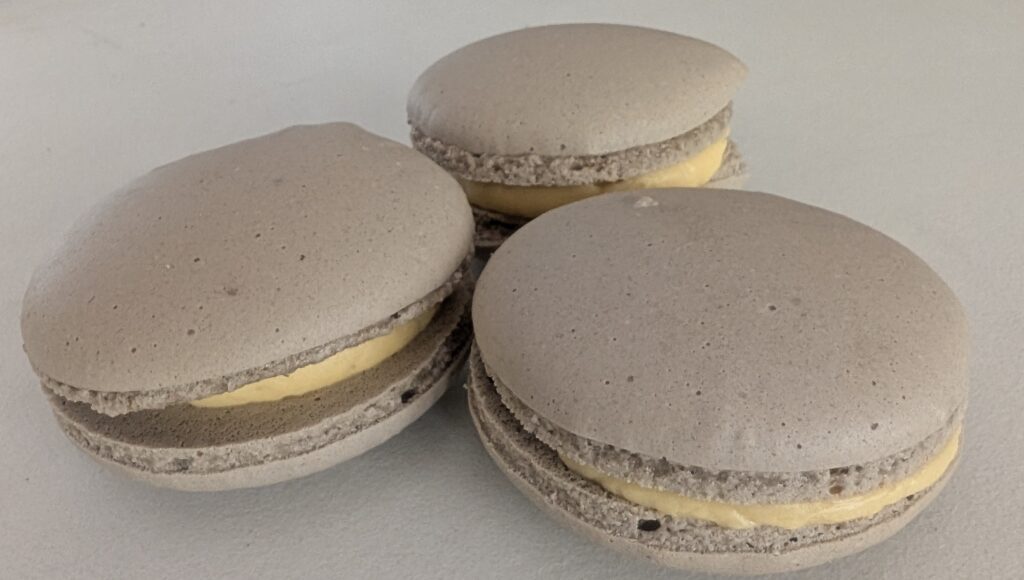The Queen of the Macaron, Nicole, gave me her recipe. It is her thing and they always look amazing. I figure it can be my thing too, if I practise often enough.
Macaron making, especially the Italian meringue method, is about following instructions, weighing not measuring, timing and temperature, exactly. It’s a science. If you follow the laid out procedure it just works. All ingredients are weighed, all timing is followed, temperatures are monitored with a laser thermometer, and all preparation is done before a single item is stirred, whipped or piped.
It doesn’t take all that long to pipe the 100 macarons that this recipe makes once you get the mojo happening. I have silicone sheets that are pre-marked with circles, that fit on my oven trays, which makes it easy to get consistent sizes and also shows how many more to pipe when it starts getting tedious. At first I used a template with circles drawn on it and put it under the baking paper, as I piped the shells on each tray, and then slid the template out and moved it to the next tray, later I upgraded to the pre-marked silicone sheets from Amazon. They don’t quite fit my trays so I cut the ends off the mats so they sit neatly and evenly on the trays.
I have found the best results come from using the black trays that come with my ovens but use them upside down.
This is my way of setting up for Macaron day.
MACARONS – ITALIAN MERINGUE
Ingredients
Weigh out the almond flour and icing sugar. Use scales and pulse in the food processor, not a high speed blender, for no more than a minute to mix it well and remove any lumps, then sieve into a large bowl, throwing out any lumps, don’t push them through. I prefer to do this twice.
If there are flavour add-ins for the shells, this is the place to incorporate them. See chocolate macarons below. There is generally a substitution of the weight of the ingredients here.
- 300g almond flour, fine white, no brown bits of skin. I looked on Amazon for one that mentioned macarons in the reviews and have found that Blue Diamond finely sifted almond powder works best for me.
- 300g pure icing sugar, not icing sugar mixture
Weigh out and put in a small bowl beside the sugar/almond flour mix
- 110g egg whites extra, at room temperature, and put it next to the flour/icing sugar mix.
Put into the bowl of the mixer with whisk attachment. It is a good idea to wipe out the mixer bowl and the whisk with some vinegar in case it has been used for something oily. I like to move the mixer next to the cooktop.
- 110g egg whites, at room temperature
Weigh into a small narrow saucepan, have a quick read digital thermometer handy. A laser thermometer has trouble when the bubbles start forming
- 300 g caster sugar
- 75 g water
- Gel food colouring, if using, generally matches or complements the colour of the ganache.
Prepare the trays
This makes 50 macarons, that’s 100 shells. I need to prepare 4 trays to accomodate the 100 shells. See note above re templates and premarked silicone sheets. Putting the trays upside down gives me better results.
Method
- Stir the almond flour and icing sugar together and blitz in pulses in a food processor until well mixed then sift twice into a large bowl. Throw out any lumps, don’t push them through.
- Put the sugar and water, in the small saucepan, over low heat and leave cooking slowly until the sugar has dissolved. It’s best not to stir or swirl it, just let it do its thing or you will be using a brush to slosh the sides to stop sugar crystals developing.
- Increase the heat on the sugar/water mix, to about 3/4 heat, bringing it to the boil. Add the food colouring (if using) at this stage. Check the temperature regularly, when it reaches 110°C turn the mixer on to medium speed, leaving it whisking while the sugar syrup comes up to 118ºC. Watch the sugar at this stage, the temperature comes up suddenly.
- Once the sugar syrup is at 118°C remove it from the heat, the egg whites should be nicely frothy and have reached soft peak stage. Add the sugar syrup to the egg whites, in a thin steady stream down the edge of the bowl, not touching the side of the bowl and not touching the beaters (a stream of hot sugar in the face is not good), to where it meets the egg whites, while the mixer is running on low speed. Then turn up the speed and continue whisking until it has cooled to warm (feel the outside of the bowl, blood temperature or cooler is the aim), about 8 minutes, a laser thermometer is handy here, aim it at the outside of the bowl to check the temperature. Medium stiff peaks should have formed. Hold the whisk upwards and watch the peaks, they should bend just slightly on the tips. Turn it off.
- Back to the almond flour and icing sugar bowl. Add the extra egg whites and 1/3 of the meringue to the dry ingredients, and using a spatula fold through until combined.
- When it is combined add another 1/3 of the meringue, folding lightly then add the last third. Continue to fold around the edges of the mixture and it will it begin to loosen. Working it more will soften the mixture. It needs to be loose enough to pipe smoothly but still hold its shape. When the mixture falls slowly and smoothly off the spatula in a continuous stream and can just make a figure 8 on the surface that stays for a few seconds then it is at the right texture. Too much mixing will produce a runny macaron that spreads out too far and doesn’t develop those famous feet.
- Transfer the mixture to 2 piping bags, each with a 7 mm plain nozzle. Squeeze the meringue down to the base of each piping bag so there are no air bubbles. I use a triangular silicone dough cutter to push it through. Fold the ends over until ready to use.
- Hold the piping bag about 1.5 cm above the marked circle on the baking sheet, and pipe straight down to make 3 cm diameter rounds, slightly bigger than the inner marked area on the silicone sheet, allowing the mix to spread out from the centre.
- To finish piping each macaron, move the nozzle clockwise, from 12 o’clock to 6 o’clock, lifting quickly at the same time. Don’t forget to stop squeezing the bag once each macaron is piped.
- The macaron will soften again slightly and the tip that formed on top of the macarons will drop, leaving a smooth top.
- As each tray is finished drop the tray, from a distance, on to the bench about 8 times so any bubbles will rise to the surface. Use a toothpick to pop bubbles near the surface and drop the tray again a few more times. It works best to do each tray as they are finished piping.
Macarons can now be dusted, using a fine sieve or tea strainer, or sprinkled with a flavour depending on the specific recipe. - Continue piping each tray, tapping, removing bubbles and dusting with topping (optional).
- Leave the macarons at room temperature for 30 minutes or more, until a skin forms. Tap the surface with your finger, it shouldn’t leave a mark and won’t be sticky. This skin is important as it lifts while the macaron cooks, creating a foot at the base, and helps to minimise cracking as it forms a seal on the top surface. The time this takes, even in the same kitchen, will vary due to humidity and temperature. Just rely on the touch test.
- While the shells are resting, preheat the oven to 165°C. Allow plenty of time for the oven to stabilise its temperature. Don’t just put the macarons in as soon as the temperature is reached. I prefer to bake one tray at a time. Everything is always different, the humidity, the kitchen temperature, even the mix. One tray at a time this allows careful monitoring of the first batch with adjustments to time and temperature being made as necessary.
- When the macarons have rested, a solid skin has formed and the oven is stable at the set temperature, bake the macarons.
- Put the tray in the middle rack of the oven and immediately lower the temperature to 135 C . This helps give a spring to get a nice foot, then time to cook slowly. Set the timer for 15 minutes but check after 12 minutes for any sign of browning and lower the temperature if necessary.
- Remove from the oven and set aside for 2 minutes, then carefully remove one macaron with a spatula to check that the base is also cooked and dry. If it is still slightly sticky, return the macarons to the oven for 2-3 minutes, then check again.
Cool the macarons completely on the trays, before trying to remove them, then pair them up according to size. One side up and the other down.
VARIATION – CHOCOLATE MACARON SHELLS
Process 60g dutch processed cocoa powder with 240 g almond meal and 270 g pure icing sugar then sift and continue as for the basic recipe.
VARIATION – GINGERBREAD MACARON SHELLS
Process ½ teaspoon ground ginger, ¼ teaspoon cinnamon, ⅛ teaspoon nutmeg, ⅛ teaspoon cloves with 300g almond meal and 300g pure icing sugar then sift and continue as for the basic recipe.
Fillings
Gingerbread Ganache

- 200g pouring cream
- 1/2 tsp molasses
- 1½ tsp ground ginger
- 1 tsp ground cinnamon
- ½ tsp ground allspice
- ⅛ teaspoon ground cloves
- ⅛ teaspoon nutmeg
- ⅛ teaspoon white pepper
- 300g white chocolate melts
- 80g butter (softened)
Method
- Put cream, spices and molasses in a saucepan and heat on low temperature for 10 minutes, whisking to incorporate the spices, to allow the flavours to infuse.
- Turn the heat to high and watch until just starting to boil.
- Pour over the white chocolate. Leave to sit, covered, for 2 minutes then mix until well combined.
- Allow to cool, to 50C, add the butter and whisk with a stick mixer until well combined.
- Leave to cool to piping temperature – about 2 hours depending on the temperature in the room. This can be speeded up by refrigerating the mix and stirring every 20 minutes until piping consistency is reached.
Dulce De Leche Ganache

Fabulous in chocolate macarons
Ingredients:
- 200g white chocolate melts
- 150g pouring cream
- 75g Nestlé Caramel Top’n’fill
- A pinch of sea salt flakes (to taste)
Instructions
Place the white chocolate in a heatproof bowl beside the stove. If it is a cool day the chocolate can be warmed, not melted, in a microwave first.
Heat the cream in a small saucepan over medium heat until it just begins to simmer.
Pour the hot cream over the chocolate and let it sit for a minute to soften, then stir gently until the chocolate is completely melted and the mixture is smooth.
Add the Caramel Top’n’fill and Salt flakes to the melted chocolate and cream and continue to stir until combined. A stick mixer is fast and gives a smooth finish. Adjust the salt to taste – I find about 1 teaspoon is right.
Cool the Ganache to room temperature, then place it in the refrigerator (or freezer for a shorter time) to thicken. This may take about 1-2 hours.
Stir occasionally to ensure even cooling.
LICORICE GANACHE
MAKES 50
Ingredients
- 175g pouring cream (35% fat)
- 45g soft chopped licorice (as fresh as possible)
- 250g white couverture chocolate, chopped or buttons
- 80g butter, chopped and softened
Method
- Put the chocolate in a small glass bowl that is tall enough to take the cream and used with a stick mixer.
- Put the cream and licorice in a saucepan over medium heat and bring to the boil. Remove from the heat and blitz the cream and licorice together with a stick mixer until smooth.
- Pour the hot licorice cream over the white chocolate and leave for 2 minutes.
- Stir until smooth, then allow the mixture to cool to 50°C.
- When the mixture is at the right temperature, blitz in the butter with a stick mixer until smooth. Allow the ganache to cool and become firm enough to pipe.
- Fill a piping bag with a 7 mm plain nozzle, with the ganache. Pipe the ganache on the flat side of half of one side of each pair of macaron shells, then top with the matching shell.
- Put the assembled macarons in the refrigerator for 24 hours to set, then bring to room temperature and serve or transfer to an airtight container forstoring for a few days or in the freezer for a month.
CANDY CANE GANACHE
MAKES 50

Ingredients
- 200g pouring cream (35% fat)
- 70g candy canes, crushed (make sure these taste good)
- 300g white melting chocolate chopped or buttons
- 60g butter chopped and softened
Method
- Put the chocolate into a small, high sided bowl.
- Put the cream and crushed candy canes in a saucepan over medium heat, bring to a simmer while stirring, making sure the candies dissolve completely.
- While the cream mix is hot pour it over the chocolate and set aside for 2 minutes.
- Stir until smooth, then allow to cool to 50°C.
- Once the chocolate mixture is at 50°C use a stick mixer to blitz in the butter until smooth.
- Allow the ganache to cool and become firm enough to pipe. It takes about 2 hours in the fridge.
- Fill a piping bag, with a 7 mm plain nozzle, with the ganache. Pipe the ganache on the flat side of half the macaron shells, then top with the remaining shells.
- Put the assembled macarons in the refrigerator for 24 hours to set, then bring to room temperature and serve or transfer to an airtight container.
- Can be frozen for up to a month in an airtight container.
SALTED GOLDEN CHOCOLATE GANACHE

Ingredients
- 200g pouring cream
- 300g golden cooking chocolate
- 80g butter, room temperature
- ½ tsp vanilla extract
- 5 g salt flakes
Method
- Put the cream over medium heat and bring to the simmer, stirring occasionally
- Put the chocolate into a small, high sided glass bowl.
- While the cream mix is hot pour it over the chocolate and set aside for 2 minutes.
- Stir until smooth, then allow to cool to 50°C. Use a laser thermometer to test. Don’t let it get too cool or it will be difficult to whisk in and may separate.
- Once the chocolate mixture is at 50°C use a stick mixer to blitz in the butter until smooth.
- Allow the ganache to cool and become firm enough to pipe. It takes about 2 hours in the fridge.
- Fill a piping bag, with a 7 mm plain nozzle, with the ganache. Pipe the ganache on the flat side of half the macaron shells, then top with the matching shells.
- Put the assembled macarons in the refrigerator for 24 hours to set, then bring to room temperature and serve or transfer to an airtight container.
- Can be frozen in an airtight container.
PISTACHIO GANACHE WITH FINGERLIME PEARLS
I absolutely love this ganache – I have made it three times.
Ingredients
- 350g white chocolate, it is quite intersting if some of this is made up of milk chocolate
- 150g pistachio cream
- 200 ml heavy cream
- 5g salt flakes
- 1/2 cup of fingerlime pearls
Method
- Put the cream in a saucepan over medium heat and bring to the simmer, stirring occasionally
- Put the chocolate and pistachio cream into a small, high sided glass bowl and microwave for 30 seconds – just to make it easier toblend when the cream is added
- While the cream mix is hot pour it over the chocolate and pistachio mix and set aside for 2 minutes.
- Stir until smooth, then allow to cool to about 50°C
- Once the chocolate mixture is at 50°C add the salt and use a stick mixer to blitz until smooth and slightly aerated.
- Allow the ganache to cool to room temperature and pour into 2 piping bags, with the with 7mm plain nozzle tips attached and bent over to stop the ganache escaping. Ensure there are no air bubbles in the mix and fold the open over to make somewhat airtight. Place on a plate in the fridge.
- Allow the ganache to cool and become firm enough to pipe. It takes about 2 hours in the fridge.
- If doing this the day before making the macarons take out of the fridge before the macaron making starts.
- Pipe the ganache in a circle on the flat side of half the macaron shells, add 1/2 tsp of fingerlime pearls to the centre then top with the matching shells.
- Put the assembled macarons in the refrigerator for 24 hours to set, then bring to room temperature and serve or transfer to an airtight container.
- Can be frozen in an airtight container straight away or after resting 24 hours.
